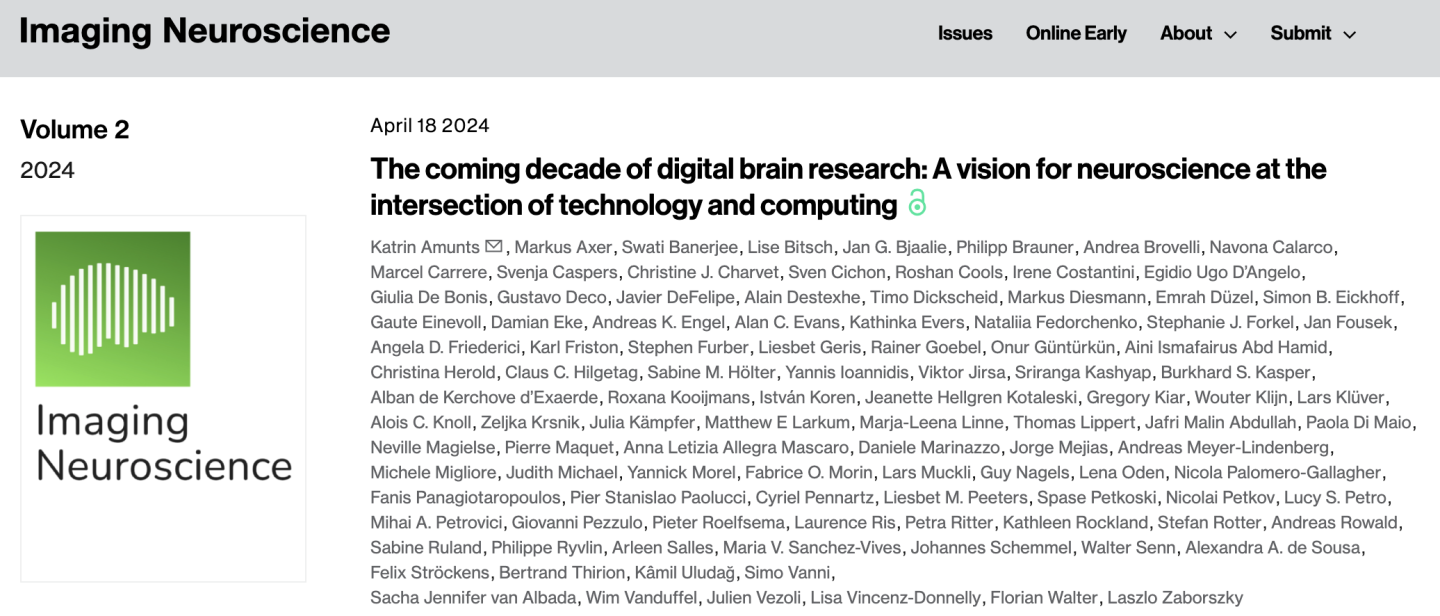
Digital technologies have fundamentally changed neuroscience in recent years. The challenges posed by increasingly large and complex data have been met with innovative shared platforms and novel tools for scientific investigation. Large-scale research initiatives within Europe and worldwide have shaped these developments and enabled synergies in scientific efforts. Examples include the EU Flagship Human Brain Project (HBP), and its digital research infrastructure EBRAINS, which enable scientists to integrate data from different scales according to FAIR principles, use models and software at EBRAINS for gaining new insights and working collaboratively on a larger scale. This change has led to significant progress and offers the opportunity to advance neuroscience, medicine and brain-inspired technologies.
Against this background, the position paper titled “The coming decade of digital brain research - A vision for neuroscience at the intersection of technology and computing” is primarily intended as a roadmap for digital neuroscience over the next ten years.
" "It is crucial that we assess, anticipate and shape the changes occuring in neuroscience and its related fields. The position paper identifies points of convergence and common goals, and provides a scientific framework for current and future developments in digital brain research based on a structured process of discussion with the research community at large." "
The position paper lists a total of eight key areas for digital neuroscience research. Near-term, middle-term and long-term goals are discussed, as well as novel developments like “digital twin”-approaches, with their applicability, potential and limitations in brain science. A “digital twin” is a type of personalised computational brain model that can be continuously updated with measured data obtained from its real-life counterpart, i.e., the patient. While not aimed at being an exact replica, the increasing sophistication and predictive power of these models is bringing new clinical and research applications into reach.
Further key areas described in the paper include ultra-high-resolution digital atlases and models of the brain that integrate multiple scales and modalities, neuro-derived artificial intelligence (AI) and computing innovations. EBRAINS has a key role in the interaction between brain research and computing, offering scientists access to the most powerful European supercomputers via the computing network Fenix and to the brain-inspired computing systems BrainScaleS and SpiNNaker. An Executive Summary of the paper has been published on the website of the EBRAINS research infrastructure.
How the position paper came about
Two years ago, the HBP initiated an open and community-driven process integrating the views of researchers around the world. A first version by around 40 authors was published on the open publication platform Zenodo in March 2022 with a call to scientists, in particular outside the HBP, to contribute further perspectives. Input from new authors led to new versions published in regular intervals and promoted for further comment. The fifth and final version has now been published in the journal Imaging Neuroscience with the contribution of over 100 authors, not only from Europe, but also from the USA, Canada and Asia.
Original Publication:
K. Amunts et al., The coming decade of digital brain research. A vision for neuroscience at the intersection of technology and computing. Imaging Neuroscience (2024).
Executive Summary:
The coming decade of digital brain research. A vision for neuroscience at the intersection of technology and computing.
Background Interview with lead author Katrin Amunts
Interview: A roadmap for digital neuroscience
Scientific contact:
k.amunts@fz-juelich.de
Contact:
press@ebrains.eu
ABOUT EBRAINS
EBRAINS is a digital research infrastructure, created by the EU-funded Human Brain Project, to foster brain-related research and to help translate the latest scientific discoveries into innovation in medicine and industry, for the benefit of patients and society. It draws on cutting-edge neuroscience and offers an extensive range of brain data sets, a multilevel brain atlas, modelling and simulation tools, easy access to high-performance computing resources and to robotics and neuromorphic platforms.
All academic researchers have open access to EBRAINS’ state-of-the art services. Industry researchers are also very welcome to use the platform under specific agreements. For more information about EBRAINS, please contact us at info@ebrains.eu or visit www.ebrains.eu.
Create an account
EBRAINS is open and free. Sign up now for complete access to our tools and services.